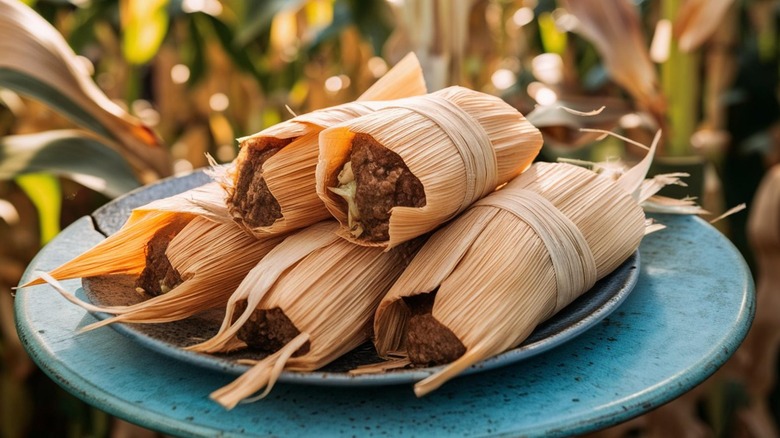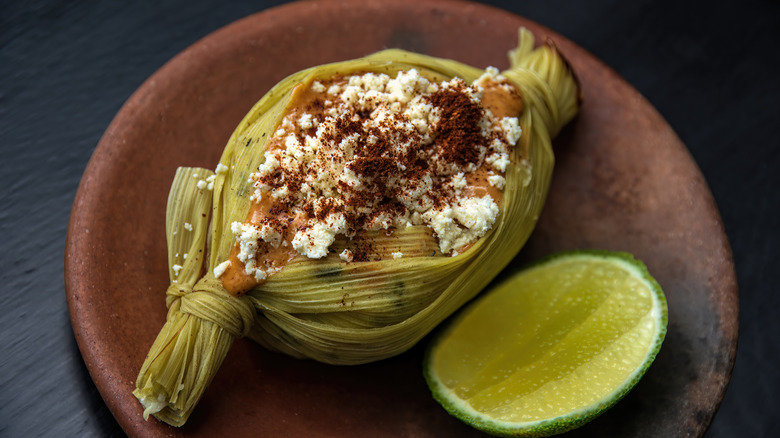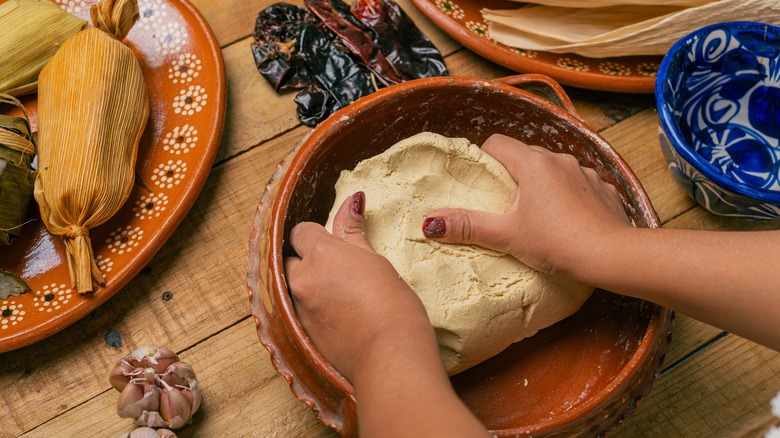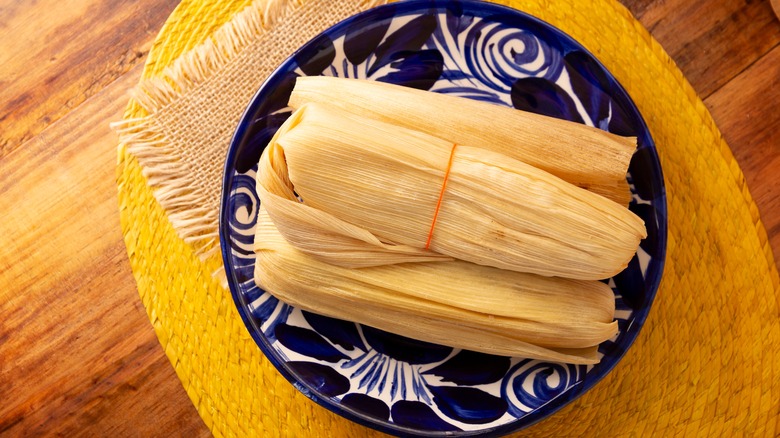The Absolute Best Cheeses To Try In Tamales
When it comes to Mexican cuisine, tamales, one of the world's oldest recipes, are about as traditional as it gets. While there are lots of ways to make tamales, lovers of this dish can have strong opinions on what makes a good one. There's little debate on whether tamales should have cheese — you can find tamales with and without cheese all over Mexico — but which cheese is best can be a controversial topic.
We spoke with Rick Martinez, author of "Mi Cocina: Recipes and Rapture from My Kitchen in Mexico," about what makes for a good tamale cheese. "I think pretty much any filling that you like is going to be a little bit better with cheese," Martinez says. "I mean, honestly, take any traditional tamale filling and then just add a little cheese and no one is going to be upset about it."
In Mexico, you'll typically find tamales made with Mexican melting cheeses like Oaxaca. One particular recipe Martinez had in Mazatlán, a tamale with rajas — which is filled with strips of poblanos, cherry tomatoes, onions, garlic, and Oaxaca cheese — inspired him to write a recipe for the New York Times. "It's so good," he says. "I mean, that's all I can say. It's delicious." But what if your grocery store doesn't have any traditional Mexican cheeses? Martinez says it's totally okay to experiment with what you have available, as long as you keep a few guidelines in mind.
Any melty cheese is fair game
In the United States, 53.6 million people live in low-income, low-access areas known as "food deserts," where access to fresh and specialty foods, including Mexican cheeses, is limited and food prices can be as much as 25% higher. If you can't get your hands on stringy Oaxaca cheese, Martinez recommends low-moisture mozzarella. "I think mozzarella honestly is probably the closest to a Oaxacan-style cheese," he says. "I would look for, I mean, this is a pretty common brand, but the Polly-O low moisture cheese, that's usually what I call for for pizzas." Another option that's relatively easy to find is Monterey jack. Both kinds of cheese can usually be found in vacuum-sealed blocks at major grocery stores, and even if your only nearby food store is a gas station, you might find Polly-O mozzarella string cheese (or something like it) there.
There are some cheeses you should avoid in the filling, though. "I would stay away from the aged cheeses, even though they're really great," Martinez says. "They're not good melting cheeses." Aged cheeses, when they melt, can separate, leaving a grainy, oily texture in your filling. "You don't want the cheese to melt and then to separate and then have this weird kind of whey seeping out," he says. "It's going to be a very unpleasant eating experience, I think." But as long as you're looking for a good melting cheese, you have a lot of room to play with tamales. Even something unconventional like blue cheese could work, as long as you're working with complementary ingredients in your filling. "I think you just have to be mindful of what you're mixing together," he says.
When in doubt, add the cheese to the dough
If you really want to get creative with cheese in your tamales but aren't sure how your favorite cheese will play along with the rest of your filling, Martinez says you can mix it into the masa dough instead, where it's not going to mess with the consistency. "Well, I'm just thinking if it separates, the corn is going to absorb the oil, so it might not ... And the graininess, the corn is already kind of grainy anyway, so it might mask the texture and absorb the oil." This opens up your tamales to some of those forbidden cheeses like parmesan, Grana Padano, and aged cheddar.
Adding cheese to the dough is also an opportunity to experiment with more non-traditional flavor combinations that you wouldn't typically associate with tamales. "This might be a little weird, but it could be — if you did maybe a Mediterranean style tamale, even a little bit of a mild feta. I wouldn't go a really crazy feta, but a mild feta in the dough."
Make a test tamale
The thing about tamales, though, is that preparing them is a time-consuming, labor-intensive process, which can make home cooks reluctant to experiment. In Mexico, making tamales is often an all-day family affair, making hundreds of tamales at once. Because of this, Martinez understands how stressful it can be to diverge from tried-and-true combinations. "It's annoying if you're going to make even three dozen tamales is a lot of effort. And then if you don't like the thing that you're making ..."
If you want to try out a new combination before you make a big batch of tamales for friends and family, Martinez recommends making a test tamale. Start by making up your masa, then cook it by pressing a teaspoon of it into a skillet instead of steaming it to make something resembling a mini tortilla. That way, you can play around with the dough and the filling until you find what you like. "Then take whatever filling you have in your mind and then just take little taste of all that in one bite," he says. "And if it tastes good, then make tamales."



